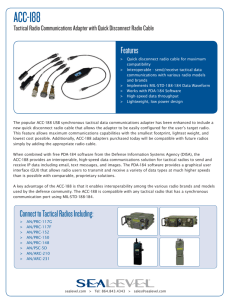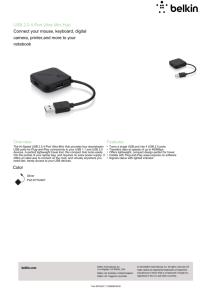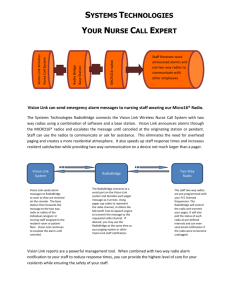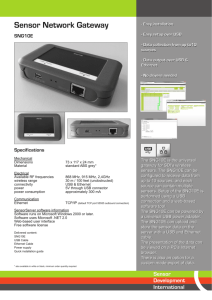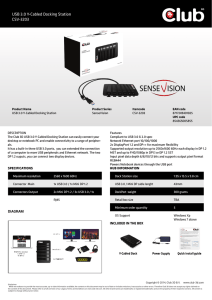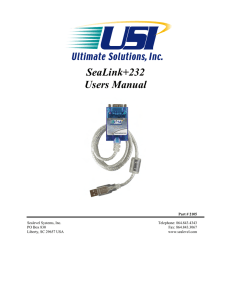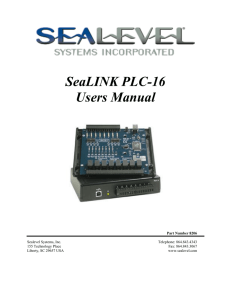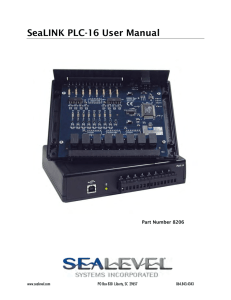Sealevel Systems announces the introduction of the ACC
advertisement
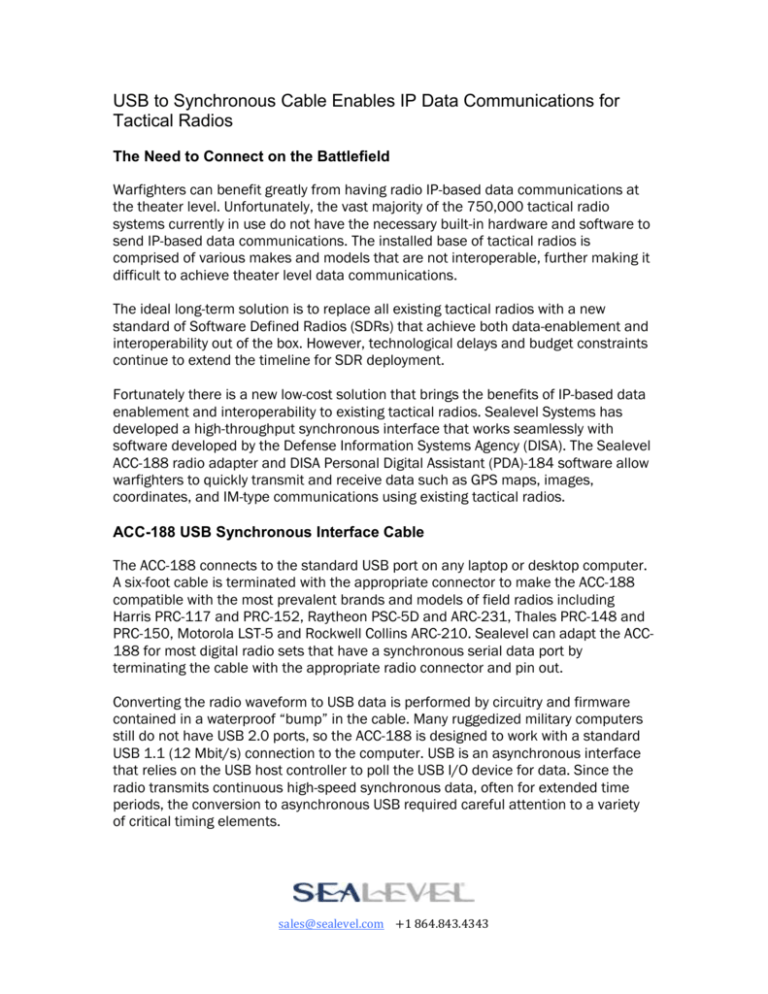
USB to Synchronous Cable Enables IP Data Communications for Tactical Radios The Need to Connect on the Battlefield Warfighters can benefit greatly from having radio IP-based data communications at the theater level. Unfortunately, the vast majority of the 750,000 tactical radio systems currently in use do not have the necessary built-in hardware and software to send IP-based data communications. The installed base of tactical radios is comprised of various makes and models that are not interoperable, further making it difficult to achieve theater level data communications. The ideal long-term solution is to replace all existing tactical radios with a new standard of Software Defined Radios (SDRs) that achieve both data-enablement and interoperability out of the box. However, technological delays and budget constraints continue to extend the timeline for SDR deployment. Fortunately there is a new low-cost solution that brings the benefits of IP-based data enablement and interoperability to existing tactical radios. Sealevel Systems has developed a high-throughput synchronous interface that works seamlessly with software developed by the Defense Information Systems Agency (DISA). The Sealevel ACC-188 radio adapter and DISA Personal Digital Assistant (PDA)-184 software allow warfighters to quickly transmit and receive data such as GPS maps, images, coordinates, and IM-type communications using existing tactical radios. ACC-188 USB Synchronous Interface Cable The ACC-188 connects to the standard USB port on any laptop or desktop computer. A six-foot cable is terminated with the appropriate connector to make the ACC-188 compatible with the most prevalent brands and models of field radios including Harris PRC-117 and PRC-152, Raytheon PSC-5D and ARC-231, Thales PRC-148 and PRC-150, Motorola LST-5 and Rockwell Collins ARC-210. Sealevel can adapt the ACC188 for most digital radio sets that have a synchronous serial data port by terminating the cable with the appropriate radio connector and pin out. Converting the radio waveform to USB data is performed by circuitry and firmware contained in a waterproof “bump” in the cable. Many ruggedized military computers still do not have USB 2.0 ports, so the ACC-188 is designed to work with a standard USB 1.1 (12 Mbit/s) connection to the computer. USB is an asynchronous interface that relies on the USB host controller to poll the USB I/O device for data. Since the radio transmits continuous high-speed synchronous data, often for extended time periods, the conversion to asynchronous USB required careful attention to a variety of critical timing elements. sales@sealevel.com +1 864.843.4343 Figure 1 shows a military laptop connected to a tactical radio using the ACC-188: The heart of the design is an 8-bit microcontroller with integrated USB port and a Field Programmable Gate Array (FPGA) device. Considering that the USB port on the host computer fully powers the ACC-188, the design is optimized to consume less than 3 watts to minimize battery drain when used with laptops. This feature is vitally important in battlefield situations where soldiers may not have the ability to recharge their laptop batteries for extended periods of time. The FPGA integrates a 256-byte Receive FIFO for receiving high-speed serial data from the radio. Using the clock signal supplied by the radio, the incoming data is clocked into the FIFO and stored until the microprocessor organizes the data into byte format and transfers the formatted data to the PC via USB packets. Similarly, on message transmission, the USB packets are sent to the Transmit FIFO and subsequently clocked out one bit at a time to the radio. Figure 2 details the ACC-188 hardware architecture: sales@sealevel.com +1 864.843.4343 sales@sealevel.com +1 864.843.4343 Intuitive Software for Fast Response DISA worked with Able Communications (Sterling, VA) and Sealevel to develop the PDA-184 software application, which implements the MIL-STD-188-184 Data Control Waveform. The PDA-184 software provides data compression, packet communications, and adaptive error-correction. Point-to-point, broadcast, and multicast messaging within a network are all supported. The PDA-184 dynamically adjusts data throughput, based on the communications channel conditions, for optimal throughput. In ideal conditions, data rates of up to 76K bps can be achieved. The software was designed for use with military Ultra High Frequency (UHF) satellite communications radios and networks, but can be applied in data communications networks that use other digital wireless transmission media, such as the High Frequency (HF) or Very High Frequency (VHF) radio frequency bands. The PDA-184 application software runs on Windows XP or 2000 operating systems and uses Sealevel’s SeaMAC V4 USB synchronous driver software for the low-level interface to the hardware. SeaMAC communicates with the radio using synchronous Raw mode, a completely unformatted method of operation. The incoming data is grouped into byte format and passed to the PDA-184 software application. All byte alignment and sync character detection is executed entirely by the PDA-184 application and can operate on a received signal with as high as a 10% bit error rate. The processing performed by the software overcomes the effects of noise on the communications channel, thereby providing highly reliable, error-free message delivery. The intuitive, interactive GUI provides maximum user control of messaging and realtime status of data transfers and allows warfighters to send and receive interactive chat notes of up to 4096 characters per transmission. File transfers up to 3MB allow important information such as maps to be received in real-time on the battlefield. The software provides email using Microsoft Outlook, Outlook Express, or other POP3/SMTP compatible email applications. For ease of use, the functional panels for communications status, transmitter queue, chat notes, address book, and email status are user configurable. Figure 3 shows a screenshot of a typical PDA-184 configuration sales@sealevel.com +1 864.843.4343 Bridging the Gap to the Tactical Radio of the Future In the late 1990s the U.S. military defined a next-generation SDR system called the Joint Tactical Radio Systems (JTRS). A variety of JTRS radios are planned ranging from handhelds to multi-band, multi-mode, multiple channel radios supporting advanced waveform capabilities and integrated networking features. These softwareprogrammable radios will provide much improved voice, data, and video communications built on the Software Communications Architecture (SCA) framework. The new radios will offer interoperability across all types of tactical radios regardless of the manufacturer or branch of military. Eventually, JTRS radios will replace more than 200 different types of radios currently deployed by the US military. Unfortunately, the technology has taken longer than anticipated to develop due to constantly changing requirements and cost overruns. The first order for a limited number of JTRS radios was issued in 2007. Perhaps the biggest obstacle for widespread deployment is the total cost of implementation. The price to taxpayers for the planned 180,000 units, at an estimated cost of $35,000 per radio, will be well over six billion dollars. Until the JTRS radio system becomes a reality, the ACC-188 USB Synchronous Serial Radio Adapter from Sealevel and the PDA-184 software from DISA provide a tested, cost-effective method for adding IP-based communications and interoperability to existing tactical radios. AUTHORS Earle Foster Earle Foster is Vice President of Sales and Marketing at Sealevel Systems, Inc. Earle has over 20 years experience in industrial computing and I/O connectivity solutions. He holds a B.S. degree in computer engineering from Clemson University. Wallace Krebs sales@sealevel.com +1 864.843.4343 Wallace Krebs leads the product marketing and SEO/SEM efforts at Sealevel Systems, Inc. He has over 15 years technical experience in midrange and commercial computing. Wallace’s background is in mechanical engineering. ABOUT SEALEVEL SYSTEMS, INC. Sealevel Systems, Inc., founded in 1986, provides industrial computing solutions in addition to a variety of communications and I/O products including PCI Bus cards, Ethernet serial servers, USB serial adapters, PCMCIA cards, and PC/104 modules. The product line includes multi-port RS-232, RS422/485, RS-232/422/485 multi-interface high-speed sync/async, and digital/relay I/O. For more information, visit www.sealevel.com or call 864-843-4343. sales@sealevel.com +1 864.843.4343

